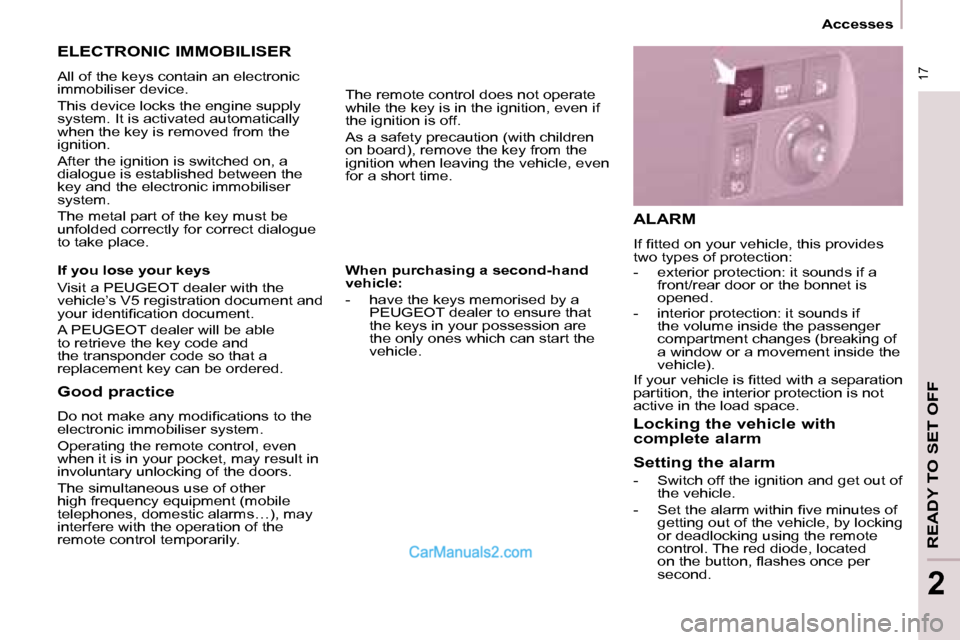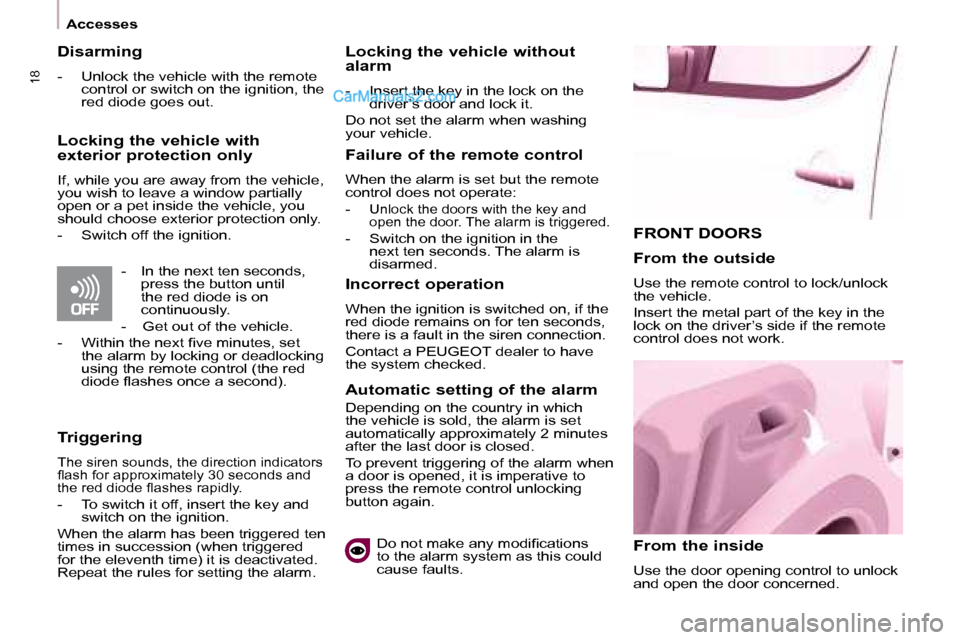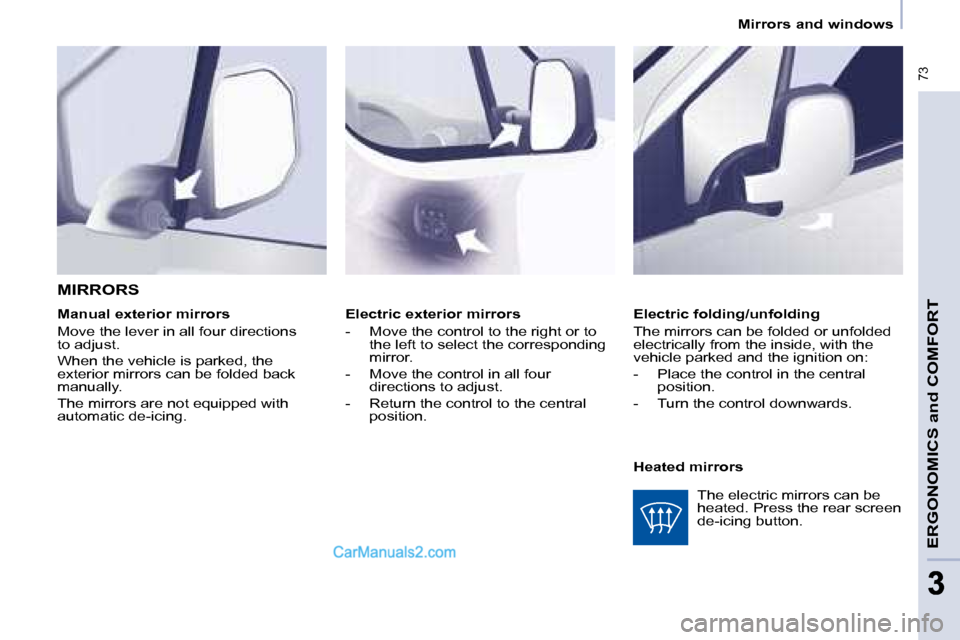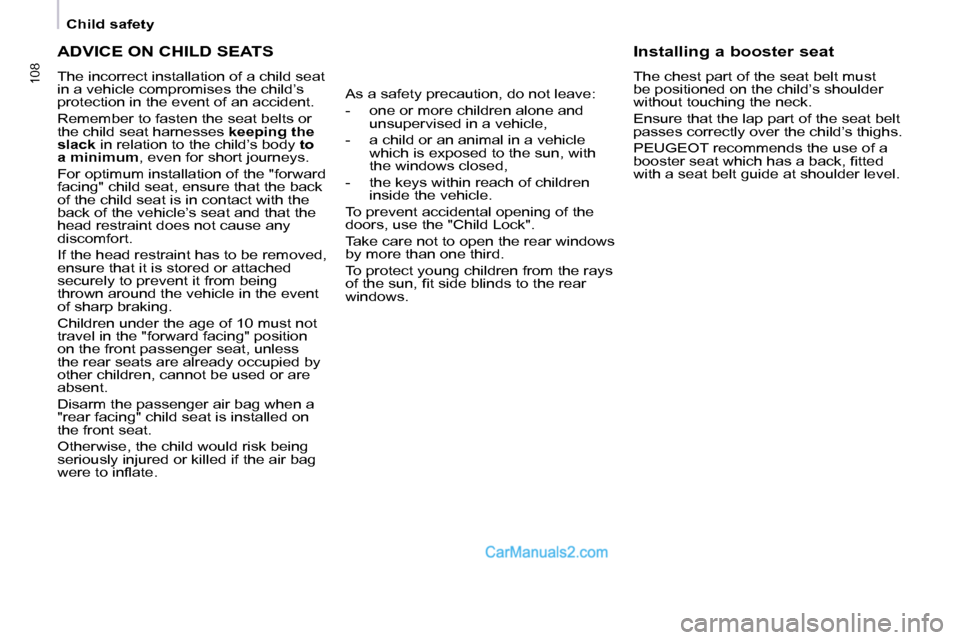window Peugeot Partner 2008.5 Owner's Manual
[x] Cancel search | Manufacturer: PEUGEOT, Model Year: 2008.5, Model line: Partner, Model: Peugeot Partner 2008.5Pages: 153, PDF Size: 3.77 MB
Page 5 of 153

9
1
FAMILIARISATION
Interior
CENTRE CONSOLE
1. Gear lever.
2. Controls bar: electric window.
3. Controls bar: hazard warning
lights, central locking (passenger
compartment, load space).
4. Lighter.
5. Heating-ventilation controls.
6. Storage compartment.
7. Audio equipment, CD changer.
8. Display.
Page 13 of 153

17
Accesses
READY TO SET OFF
2
When purchasing a second-hand
vehicle:
- have the keys memorised by a PEUGEOT dealer to ensure that
the keys in your possession are
the only ones which can start the
vehicle.
Good practice
� �D�o� �n�o�t� �m�a�k�e� �a�n�y� �m�o�d�i�fi� �c�a�t�i�o�n�s� �t�o� �t�h�e�
electronic immobiliser system.
Operating the remote control, even
when it is in your pocket, may result in
involuntary unlocking of the doors.
The simultaneous use of other
high frequency equipment (mobile
telephones, domestic alarms…), may
interfere with the operation of the
remote control temporarily.
ELECTRONIC IMMOBILISER
All of the keys contain an electronic
immobiliser device.
This device locks the engine supply
system. It is activated automatically
when the key is removed from the
ignition.
After the ignition is switched on, a
dialogue is established between the
key and the electronic immobiliser
system.
The metal part of the key must be
unfolded correctly for correct dialogue
to take place.
If you lose your keys
Visit a PEUGEOT dealer with the
vehicle’s V5 registration document and
�y�o�u�r� �i�d�e�n�t�i�fi� �c�a�t�i�o�n� �d�o�c�u�m�e�n�t�.�
A PEUGEOT dealer will be able
to retrieve the key code and
the transponder code so that a
replacement key can be ordered. The remote control does not operate
while the key is in the ignition, even if
the ignition is off.
As a safety precaution (with children
on board), remove the key from the
ignition when leaving the vehicle, even
for a short time.
ALARM
� �I�f� �fi� �t�t�e�d� �o�n� �y�o�u�r� �v�e�h�i�c�l�e�,� �t�h�i�s� �p�r�o�v�i�d�e�s�
two types of protection:
- exterior protection: it sounds if a
front/rear door or the bonnet is
opened.
- interior protection: it sounds if the volume inside the passenger
compartment changes (breaking of
a window or a movement inside the
vehicle).
� �I�f� �y�o�u�r� �v�e�h�i�c�l�e� �i�s� �fi� �t�t�e�d� �w�i�t�h� �a� �s�e�p�a�r�a�t�i�o�n�
partition, the interior protection is not
active in the load space.
Locking the vehicle with
complete alarm
Setting the alarm
- Switch off the ignition and get out of the vehicle.
� � �-� � �S�e�t� �t�h�e� �a�l�a�r�m� �w�i�t�h�i�n� �fi� �v�e� �m�i�n�u�t�e�s� �o�f� getting out of the vehicle, by locking
or deadlocking using the remote
control. The red diode, located
�o�n� �t�h�e� �b�u�t�t�o�n�,� �fl� �a�s�h�e�s� �o�n�c�e� �p�e�r�
second.
Page 14 of 153

18
Accesses
FRONT DOORS
From the inside
Use the door opening control to unlock
and open the door concerned.
From the outside
Use the remote control to lock/unlock
the vehicle.
Insert the metal part of the key in the
lock on the driver’s side if the remote
control does not work.
Triggering
The siren sounds, the direction indicators
�fl� �a�s�h� �f�o�r� �a�p�p�r�o�x�i�m�a�t�e�l�y� �3�0� �s�e�c�o�n�d�s� �a�n�d�
�t�h�e� �r�e�d� �d�i�o�d�e� �fl� �a�s�h�e�s� �r�a�p�i�d�l�y�.�
- To switch it off, insert the key and switch on the ignition.
When the alarm has been triggered ten
times in succession (when triggered
for the eleventh time) it is deactivated.
Repeat the rules for setting the alarm. Locking the vehicle without
alarm
- Insert the key in the lock on the
driver’s door and lock it.
Do not set the alarm when washing
your vehicle.
Failure of the remote control
When the alarm is set but the remote
control does not operate:
-
Unlock the doors with the key and
open the door. The alarm is triggered.
- Switch on the ignition in the next ten seconds. The alarm is
disarmed.
Incorrect operation
When the ignition is switched on, if the
red diode remains on for ten seconds,
there is a fault in the siren connection.
Contact a PEUGEOT dealer to have
the system checked.
Automatic setting of the alarm
Depending on the country in which
the vehicle is sold, the alarm is set
automatically approximately 2 minutes
after the last door is closed.
To prevent triggering of the alarm when
a door is opened, it is imperative to
press the remote control unlocking
button again.
� �D�o� �n�o�t� �m�a�k�e� �a�n�y� �m�o�d�i�fi� �c�a�t�i�o�n�s�
to the alarm system as this could
cause faults.
Locking the vehicle with
exterior protection only
If, while you are away from the vehicle,
you wish to leave a window partially
open or a pet inside the vehicle, you
should choose exterior protection only.
- Switch off the ignition.
- In the next ten seconds, press the button until
the red diode is on
continuously.
- Get out of the vehicle.
� � �-� � �W�i�t�h�i�n� �t�h�e� �n�e�x�t� �fi� �v�e� �m�i�n�u�t�e�s�,� �s�e�t� the alarm by locking or deadlocking
using the remote control (the red
�d�i�o�d�e� �fl� �a�s�h�e�s� �o�n�c�e� �a� �s�e�c�o�n�d�)�.� � �
Disarming
- Unlock the vehicle with the remote
control or switch on the ignition, the
red diode goes out.
Page 54 of 153

56
Ventilation
GOOD PRACTICE
Vents
"Leave them open"
For optimum distribution and diffusion
of hot or cool air in the passenger
compartment, there are adjustable
central and side vents which can
be directed sideways (right or left)
or vertically (up or down). For your
comfort while driving, do not close
�t�h�e�m� �a�n�d� �d�i�r�e�c�t� �t�h�e� �fl� �o�w� �o�f� �a�i�r� �t�o�w�a�r�d�s�
the windows instead.
Air vents in the footwells and directed
towards the windscreen complete the
equipment.
Do not block the vents located at the
windscreen or the air extractor located
in the boot.
Dust filter, odour filter
(activated carbon)
� �T�h�i�s� �fi� �l�t�e�r� �t�r�a�p�s� �c�e�r�t�a�i�n� �d�u�s�t� �a�n�d� �l�i�m�i�t�s�
odours.
� �E�n�s�u�r�e� �t�h�a�t� �t�h�i�s� �fi� �l�t�e�r� �i�s� �i�n� �g�o�o�d�
�c�o�n�d�i�t�i�o�n� �a�n�d� �h�a�v�e� �a�l�l� �o�f� �t�h�e� �fi� �l�t�e�r�
elements replaced regularly.
Refer to the "Checks" section of
chapter 7. Air conditioning
In all seasons, the air conditioning should
only be used with the windows closed.
However, if the interior temperature
remains high after a prolonged period
parked in the sun, do not hesitate
to ventilate the passenger compartment
for a few minutes.
Use the AUTO mode as much as
possible as it permits optimised
�c�o�n�t�r�o�l� �o�f� �a�l�l� �o�f� �t�h�e� �f�u�n�c�t�i�o�n�s�:� �a�i�r� �fl� �o�w�,�
passenger compartment comfort
temperature, air distribution, air
intake mode or air recirculation in the
passenger compartment.
Operate the air conditioning system for
5 to 10 minutes, once or twice a month,
to keep it in perfect working order.
It is normal that the condensation
created by the air conditioning system
�r�e�s�u�l�t�s� �i�n� �a� �fl� �o�w� �o�f� �w�a�t�e�r� �w�h�i�c�h� �m�a�y�
form a puddle under the vehicle when
parked.
If the system does not produce cold air,
do not use it and contact a PEUGEOT
dealer.
Automatic mode: visibility
programme
The comfort programme (AUTO) may
�n�o�t� �b�e� �s�u�f�fi� �c�i�e�n�t� �t�o� �q�u�i�c�k�l�y� �d�e�m�i�s�t� �o�r�
de-ice the windows (humidity, several
passengers, ice).
In this case, select the visibility
programme. The visibility programme
indicator light comes on.
It activates the air conditioning, the air
�fl� �o�w� �a�n�d� �p�r�o�v�i�d�e�s� �o�p�t�i�m�u�m� �d�i�s�t�r�i�b�u�t�i�o�n�
of the ventilation to the windscreen and
side windows.
It deactivates the air recirculation.
Page 73 of 153

73
ERGONOMICS and COMFORT
33
Mirrors and windows
Electric exterior mirrors
- Move the control to the right or to the left to select the corresponding
mirror.
- Move the control in all four directions to adjust.
- Return the control to the central position. Electric folding/unfolding
The mirrors can be folded or unfolded
electrically from the inside, with the
vehicle parked and the ignition on:
- Place the control in the central
position.
- Turn the control downwards.
MIRRORS
Heated mirrors
Manual exterior mirrors
Move the lever in all four directions
to adjust.
When the vehicle is parked, the
exterior mirrors can be folded back
manually.
The mirrors are not equipped with
automatic de-icing.
The electric mirrors can be
heated. Press the rear screen
de-icing button.
Page 74 of 153

74
Mirrors and windows
Forced folding
If the mirror casing has come out of
its initial location, with the vehicle
stationary reposition the mirror casing
manually or use the electric folding
control. Manual interior mirror
The interior mirror has two positions:
- day (normal),
- night (anti-dazzle).
To change from one to the other, push
or pull the lever on the lower edge of
the mirror. Areas for toll cards/
car park tickets
The athermic windscreen has two non-
�r�e�fl� �e�c�t�i�v�e� �z�o�n�e�s� �l�o�c�a�t�e�d� �e�i�t�h�e�r� �s�i�d�e� �o�f�
the base of the interior mirror.
� �T�h�e�y� �a�r�e� �i�n�t�e�n�d�e�d� �f�o�r� �a�f�fi� �x�i�n�g� �t�o�l�l� �c�a�r�d�s�
and/or car park tickets.
Page 75 of 153

75
ERGONOMICS and COMFORT
33
Mirrors and windows
ELECTRIC WINDOWS
1. Driver’s electric window control
2. Passenger electric window control
There are two operating modes:
Safety auto-reverse
When the window rises and meets an
obstacle, it stops and partially lowers.
Automatic mode
Press or pull the control, beyond the
point of resistance. The window opens
or closes fully when the control is
released. Pressing the control again
stops the movement of the window.
The electrical functions of the electric
windows are deactivated:
- approximately 45 seconds after
the ignition is switched off,
- after one of the front doors is opened, if the ignition is off.
Manual mode
Press or pull the control, without passing
the point of resistance. The window
stops when you release the control.
Reinitialisation
Following reconnection of the battery,
or in the event of a malfunction, the
safety auto-reverse function must be
reinitialised. Good practice
If the electric windows meet an
obstacle during operation, you must
reverse the movement of the window.
To do this, press the control concerned.
When the driver operates the
passenger electric window controls, he
must ensure that no one is preventing
correct closing of the windows.
The driver must ensure that the
passengers use the electric windows
correctly.
Be aware of children when operating
the windows.
Following several consecutive closing/
opening operations of the electric
window control, a protection system is
triggered which only authorises closing
of the window. After closing, wait
approximately 40 minutes. Once this
time has elapsed, the control becomes
operational again.
Lower the window fully, then raise it, it
will rise in steps of a few centimetres
each time the control is pressed.
Repeat the operation until the window
is fully closed.
Continue to press the control for at
least one second after the window
closed position has been reached.
The safety auto-reverse does not
operate during these operations.
Page 104 of 153

101
SAFETY
101
55
Air bags
Side air bags
This is a system which protects the
driver and front passenger in the event
of a serious side impact in order to limit
the risk of injury to the chest.
Each side air bag is incorporated in the
front seat back frame, on the door side.
Activation
It is triggered unilaterally in the event
of a serious side impact applied to
all or part of the side impact zone
B , perpendicular to the longitudinal
centreline of the vehicle on a horizontal
plane and directed from the outside
towards the inside of the vehicle.
� �T�h�e� �s�i�d�e� �a�i�r� �b�a�g� �i�n�fl� �a�t�e�s� �b�e�t�w�e�e�n� �t�h�e�
front occupant of the vehicle and the
corresponding door trim pad. Impact detection zones
A. Front impact zone.
B. Side impact zone.
In the event of a minor impact or
bump on the side of the vehicle or
if the vehicle rolls over, the air bag
may not be triggered. Operating fault
If this warning light comes
on on the instrument panel,
accompanied by an audible
signal and a message
on the display, contact a
PEUGEOT dealer to have the system
checked. The air bags may no longer
be triggered in the event of a serious
impact.
Curtain air bags
This is a system which protects the
driver and passengers in the event of a
serious side impact in order to limit the
risk of head injuries.
Each curtain air bag is incorporated
in the pillars and the upper part of the
passenger compartment.
Activation
It is triggered at the same time as
the corresponding side air bag in the
event of a serious side impact applied
to all or part of the side impact zone
B , perpendicular to the longitudinal
centreline of the vehicle on a horizontal
plane and directed from the outside
towards the inside of the vehicle.
� �T�h�e� �c�u�r�t�a�i�n� �a�i�r� �b�a�g� �i�n�fl� �a�t�e�s� �b�e�t�w�e�e�n�
the occupant of the vehicle and the
windows.
Page 108 of 153

108108
Child safety
ADVICE ON CHILD SEATS
The incorrect installation of a child seat
in a vehicle compromises the child’s
protection in the event of an accident.
Remember to fasten the seat belts or
the child seat harnesses keeping the
slack in relation to the child’s body to
a minimum , even for short journeys.
For optimum installation of the "forward
facing" child seat, ensure that the back
of the child seat is in contact with the
back of the vehicle’s seat and that the
head restraint does not cause any
discomfort.
If the head restraint has to be removed,
ensure that it is stored or attached
securely to prevent it from being
thrown around the vehicle in the event
of sharp braking.
Children under the age of 10 must not
travel in the "forward facing" position
on the front passenger seat, unless
the rear seats are already occupied by
other children, cannot be used or are
absent.
Disarm the passenger air bag when a
"rear facing" child seat is installed on
the front seat.
Otherwise, the child would risk being
seriously injured or killed if the air bag
�w�e�r�e� �t�o� �i�n�fl� �a�t�e�.� As a safety precaution, do not leave:
- one or more children alone and
unsupervised in a vehicle,
- a child or an animal in a vehicle which is exposed to the sun, with
the windows closed,
- the keys within reach of children inside the vehicle.
To prevent accidental opening of the
doors, use the "Child Lock".
Take care not to open the rear windows
by more than one third.
To protect young children from the rays
�o�f� �t�h�e� �s�u�n�,� �fi� �t� �s�i�d�e� �b�l�i�n�d�s� �t�o� �t�h�e� �r�e�a�r�
windows. Installing a booster seat
The chest part of the seat belt must
be positioned on the child’s shoulder
without touching the neck.
Ensure that the lap part of the seat belt
passes correctly over the child’s thighs.
PEUGEOT recommends the use of a
�b�o�o�s�t�e�r� �s�e�a�t� �w�h�i�c�h� �h�a�s� �a� �b�a�c�k�,� �fi� �t�t�e�d�
with a seat belt guide at shoulder level.
Page 117 of 153

111
ACCESSORIES
66
Equipment
Anti-theft alarm, window
�e�n�g�r�a�v�i�n�g�,� �fi� �r�s�t� �a�i�d� �k�i�t�,� �h�i�g�h�
visibility safety jacket, rear
parking assistance, warning
triangle, ...
Front seat covers compatible
with air bags, bench, rubber
mats, carpet mats, snow chains,
blind, tailgate bicycle carrier, ...
Audio equipment, hands-free
kit, speakers, CD changer,
navigation, ...
To prevent the mat from becoming
caught under the pedals:
� � � �-� � �e�n�s�u�r�e� �t�h�a�t� �t�h�e� �m�a�t� �a�n�d� �i�t�s� �fi� �x�i�n�g�s�
are positioned correctly,
� � �-� � �n�e�v�e�r� �fi� �t� �o�n�e� �m�a�t� �o�n� �t�o�p� �o�f� �a�n�o�t�h�e�r�.� � �
Regardless of the audio and telematic
equipment offered on the market, the
technical constraints linked with the
�fi� �t�t�i�n�g� �o�f� �e�q�u�i�p�m�e�n�t� �o�f� �t�h�e�s�e� �f�a�m�i�l�i�e�s�
of products mean that the special
features of the equipment and its
compatibility with the capacities of the
your vehicle’s standard equipment
must be taken into account. Please
contact a PEUGEOT dealer for
�i�n�f�o�r�m�a�t�i�o�n� �b�e�f�o�r�e� �fi� �t�t�i�n�g� �s�u�c�h�
equipment. Maximum weights on bars
- Roof rack: 120 Kg.
- Transverse bars on roof: 100 Kg.
- Transverse bars on longitudinal
bars: 75 Kg.
Installation of radiocommunication
transmitters
Before installing accessory
radiocommunication transmitters with
an external aerial on your vehicle, you
are advised to contact a representative
of the PEUGEOT marque.
The PEUGEOT Network will inform you
�o�f� �t�h�e� �s�p�e�c�i�fi� �c�a�t�i�o�n�s� �(�f�r�e�q�u�e�n�c�y� �b�a�n�d�,�
maximum output power, aerial position,
�s�p�e�c�i�fi� �c� �i�n�s�t�a�l�l�a�t�i�o�n� �c�o�n�d�i�t�i�o�n�s�)� �o�f� �t�h�e�
�t�r�a�n�s�m�i�t�t�e�r�s� �w�h�i�c�h� �c�a�n� �b�e� �fi� �t�t�e�d�,� �i�n�
accordance with the Motor Vehicle
Electromagnetic Compatibility Directive
(2004/104/CE).
� � �F�r�o�n�t� �m�u�d� �fl� �a�p�s�,� �r�e�a�r� �m�u�d�
�fl� �a�p�s�,� �1�5�/�1�7� �i�n�c�h� �a�l�l�o�y� �w�h�e�e�l�s�,�
wheelarch trim, leather steering
wheel, ...
Screenwash, interior and
exterior cleaning and
maintenance products,
replacement bulbs, ... � � �T�h�e� �fi� �t�t�i�n�g� �o�f� �e�l�e�c�t�r�i�c�a�l� �e�q�u�i�p�m�e�n�t�
or accessories which are not
recommended by Automobiles
PEUGEOT may result in the failure
of your vehicle’s electronic system.
�P�l�e�a�s�e� �n�o�t�e� �t�h�i�s� �s�p�e�c�i�fi� �c� �w�a�r�n�i�n�g�.� �Y�o�u�
are advised to contact a representative
of the Marque to be shown the range
of recommended equipment and
accessories.
Depending on the country in which
the vehicle is sold or operated, it is
compulsory to have a high visibility
safety jacket, warning triangle and
replacement bulbs available in the
vehicle.
"Active Fleet Data" Telematic unit
Connected directly to the heart of the
vehicle (multiplexed network: "Full
CAN"), the telematic unit, by means of
a "ready to use" service, permits the
sending in real time of information such
as:
- distance travelled,
- distance remaining before the next service,
- warnings and faults (oil level, coolant level, oil temperature,
coolant temperature, etc...).
This enables "Fleet" managers
to optimise the monitoring and
management of their professional
vehicles.
According to country, contact
a PEUGEOT dealer for further
information.